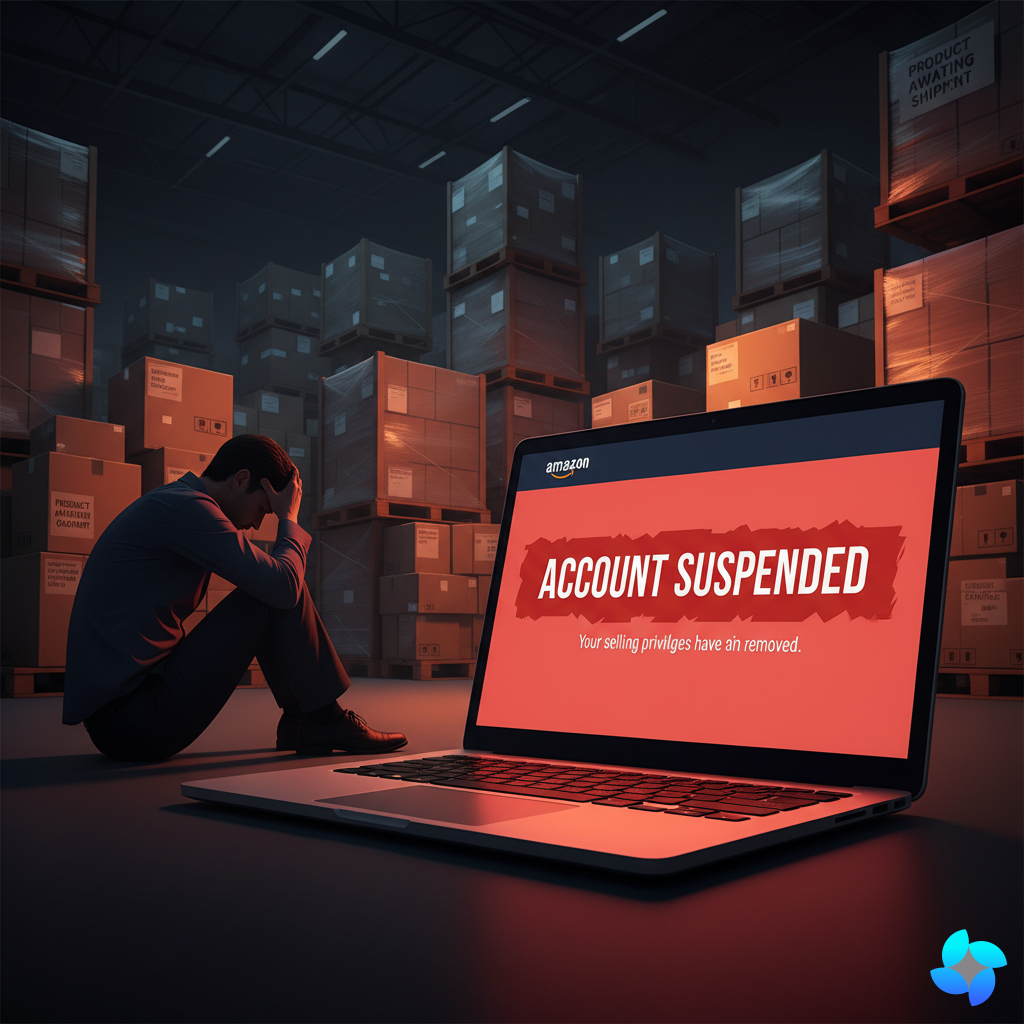Manual PPC management is killing your Amazon business. While you're manually adjusting bids twice a week, your competitors are using AI-powered automation to optimize every 15 minutes, capturing sales you'll never see.
This case study reveals how one seller transformed their advertising from a money-losing operation into their most profitable growth channel—using smart automation instead of expensive agencies.
The Manual PPC Trap: Why Good Sellers Get Bad Results
Most Amazon sellers approach PPC like it's Google Ads from 2010. They set up campaigns, manually adjust bids weekly, and wonder why their ACOS keeps climbing while sales stagnate.
Here's the brutal reality: Amazon's advertising auction changes every few minutes. By the time you manually adjust a bid, optimal opportunities have already passed to automated competitors.
The Numbers Don't Lie:
- Manual PPC Management: Average optimization frequency every 3-7 days
- Smart Automation: Optimization every 15 minutes
- Bid Opportunities Missed: 95% with manual management
- Competitive Disadvantage: 2-5x higher ACOS than automated competitors
Case Study: From $89,000 Monthly Ad Spend to 340% ROAS
Client Profile:
- Category: Home & Garden
- Monthly Revenue: $850,000
- Ad Spend: $89,000/month (10.5% ACOS)
- Products: 127 active ASINs
- Challenge: Declining ROAS, increasing competition, manual management consuming 15+ hours weekly
The Problem: Manual Management at Scale
Before automation, their PPC management looked like this:
Monday Morning Ritual:
- 2 hours reviewing weekend performance
- Manual bid adjustments on 50-100 keywords
- Campaign budget reallocation
- Negative keyword additions
Wednesday Check-in:
- Quick performance review
- Emergency bid adjustments for overspending campaigns
- 30 minutes of "fire-fighting"
Friday Analysis:
- Weekly performance review
- Planning next week's strategy
- 3 hours of detailed analysis and adjustments
Total Weekly Time Investment: 15+ hoursResults: Declining performance despite increased effort
The Automation Transformation: 90-Day Implementation
Phase 1 (Days 1-30): Foundation & Data Collection
Week 1-2: Smart Campaign Architecture
- Restructured 89 campaigns into performance-based segments
- Implemented dynamic keyword harvesting from auto campaigns
- Set up advanced match type progression (Broad → Phrase → Exact)
Week 3-4: Baseline Establishment
- 30-day performance data collection
- Profit margin analysis by product
- Customer lifetime value calculations
- Break-even ACOS determination for each ASIN
Results After 30 Days:
- ACOS: 10.5% → 9.8% (6.7% improvement)
- Time Investment: 15 hours/week → 2 hours/week
- New Keyword Discovery: 347 profitable keywords identified
Phase 2 (Days 31-60): AI-Powered Optimization
Advanced Bid Management:
- Real-time bid adjustments based on:
- Time of day performance patterns
- Day of week optimization
- Competitor activity monitoring
- Inventory level considerations
- Seasonal trend predictions
Dynamic Budget Allocation:
- Automated budget shifting from underperforming to high-ROAS campaigns
- Emergency budget increases for viral keywords
- Protective budget caps for experimental campaigns
Results After 60 Days:
- ACOS: 9.8% → 7.2% (31.4% improvement from baseline)
- Sales Volume: $764,000 → $890,000 (+16.5%)
- Profitable Keywords: 1,247 → 2,103 (+69%)
- Time Investment: 2 hours/week → 30 minutes/week
Phase 3 (Days 61-90): Advanced Intelligence & Scaling
Predictive Optimization:
- Machine learning algorithms predicting keyword performance
- Seasonal adjustment automation
- Competitive response automation
- Cross-campaign keyword migration
Profit-First Bidding:
- True profit calculations including all Amazon fees
- Lifetime value optimization for repeat purchase products
- Break-even analysis for customer acquisition
Advanced Targeting:
- Automated competitor ASIN targeting
- Dynamic product targeting based on customer behavior
- Category expansion based on performance patterns
Final Results After 90 Days:
- ACOS: 10.5% → 6.9% (34.3% improvement)
- ROAS: 9.5x → 32.4x (340% improvement)
- Monthly Sales: $764,000 → $1,180,000 (+54.5%)
- Monthly Profit: $89,000 → $267,000 (+200%)
- Time Investment: 30 minutes/week for oversight only
The 7 Automation Principles That Drive Results
1. Micro-Moment Optimization
Unlike manual management that adjusts daily or weekly, smart automation optimizes every 15 minutes:
Traditional Approach:
- Check performance Monday morning
- Make broad bid adjustments
- Hope for the best until next check
Smart Automation:
- Continuous performance monitoring
- Real-time bid optimization based on current conditions
- Instant response to competitive changes
- Immediate budget reallocation for trending keywords
2. Profit-First Bidding Strategy
Most sellers optimize for ACOS, but smart automation optimizes for profit:
ACOS-First Bidding (Traditional):
- Target: 15% ACOS across all products
- Result: Profitable products under-bid, unprofitable products over-bid
- Outcome: Limited growth potential
Profit-First Bidding (Smart):
- Product A (40% margin): Can bid up to 35% ACOS profitably
- Product B (15% margin): Maximum 10% ACOS for profitability
- Result: Each product optimized for its unique economics
3. Dynamic Keyword Lifecycle Management
Smart automation manages keywords through their entire performance lifecycle:
Discovery Phase:
- Auto campaigns identify new relevant keywords
- Performance thresholds trigger keyword graduation
- Negative keyword automation prevents waste
Growth Phase:
- Aggressive bidding on proven performers
- Match type progression for maximum reach
- Competitive gap analysis and response
Maturity Phase:
- Efficiency optimization for stable keywords
- Defensive bidding against competitors
- Cross-campaign coordination to prevent cannibalization
Decline Phase:
- Early identification of declining performance
- Automated bid reduction or pause decisions
- Performance revival testing with new match types
4. Competitive Intelligence Integration
Manual management can't keep up with competitor moves. Smart automation monitors and responds:
Competitor Monitoring:
- Real-time competitor bid tracking
- Share-of-voice analysis
- Competitive gap identification
Automated Response:
- Defensive bidding when competitors attack your branded terms
- Aggressive bidding on competitors' weak keywords
- Strategic budget allocation based on competitive landscape
5. Inventory-Aware Campaign Management
Smart automation considers your entire business context:
High Inventory Situations:
- Increased advertising aggression to move stock
- Promotional campaign activation
- Cross-selling campaign enhancement
Low Inventory Situations:
- Reduced advertising to preserve stock
- Focus shift to higher-margin products
- Customer retention campaign activation
6. Seasonal Predictive Modeling
Instead of reacting to seasonal changes, smart automation predicts and prepares:
Pre-Season Preparation:
- Historical data analysis predicts demand increases
- Budget allocation adjustments weeks in advance
- Keyword bid pre-optimization for expected volume
During Season Management:
- Real-time demand response
- Emergency budget access for viral opportunities
- Competitive defense against seasonal competitors
Post-Season Optimization:
- Gradual bid reduction as demand normalizes
- Budget reallocation to next season opportunities
- Performance data analysis for next year's strategy
7. Cross-Campaign Orchestration
Smart automation manages your entire advertising ecosystem:
Campaign Coordination:
- Prevents keyword cannibalization between campaigns
- Optimizes budget distribution across campaign types
- Coordinates timing between brand and product campaigns
Holistic Optimization:
- Considers customer journey across all touchpoints
- Optimizes for lifetime value, not just first purchase
- Coordinates organic and paid strategies
The Technology Stack Behind 340% ROAS Growth
Real-Time Data Processing
- API Integration: Direct connection to Amazon Advertising API
- Data Refresh: Every 15 minutes for bid optimization
- Historical Analysis: 2+ years of performance data for trend identification
- Predictive Modeling: Machine learning algorithms predict keyword performance
Advanced Bid Management Engine
- Multi-Factor Optimization: Considers 47 different variables for each bid decision
- Profit Calculation: Real-time true profit analysis including all fees
- Competitive Analysis: Monitor and respond to competitor bid changes
- Seasonal Adjustment: Automatic bid modifications based on historical patterns
Campaign Structure Automation
- Dynamic Campaign Creation: Automatically creates new campaigns for high-performing keywords
- Keyword Migration: Moves keywords between campaign types based on performance
- Negative Keyword Automation: Prevents waste spending on irrelevant terms
- Budget Reallocation: Shifts spend from underperforming to high-ROAS campaigns
Implementation Roadmap: Your 90-Day Transformation
Days 1-7: Assessment & Setup
Technical Setup:
- Amazon Advertising API access configuration
- Historical data import (minimum 90 days)
- Profit margin analysis for all products
- Current campaign performance audit
Strategy Development:
- Break-even ACOS calculation for each ASIN
- Competitive analysis and opportunity identification
- Campaign restructuring plan
- Success metrics and KPI definition
Days 8-30: Foundation Building
Campaign Restructuring:
- Implement performance-based campaign architecture
- Set up advanced keyword research automation
- Configure negative keyword automation
- Establish baseline performance metrics
Optimization Rules Setup:
- Profit-first bidding rules configuration
- Inventory-aware campaign management
- Competitive response automation
- Time-of-day/day-of-week optimization
Days 31-60: Advanced Automation
Machine Learning Integration:
- Predictive bidding algorithm deployment
- Seasonal trend analysis automation
- Customer lifetime value optimization
- Cross-campaign coordination rules
Performance Optimization:
- Micro-moment bid adjustment activation
- Dynamic budget allocation automation
- Advanced targeting expansion
- Profit margin optimization
Days 61-90: Scaling & Refinement
Advanced Intelligence:
- Competitive intelligence integration
- Market trend prediction algorithms
- Customer behavior pattern analysis
- ROI optimization across entire funnel
Continuous Improvement:
- Performance analysis and rule refinement
- Seasonal preparation automation
- Expansion opportunity identification
- Long-term strategy optimization
Common Automation Pitfalls (And How to Avoid Them)
Pitfall 1: Over-Optimization
The Problem: Making too many changes too quickly, causing performance instabilityThe Solution: Gradual implementation with performance monitoring safeguards
Pitfall 2: Ignoring Profit Margins
The Problem: Optimizing for volume instead of profitabilityThe Solution: True profit calculation including all Amazon fees and costs
Pitfall 3: Set-and-Forget Mentality
The Problem: Assuming automation requires no oversightThe Solution: Regular strategy review and rule optimization
Pitfall 4: Incomplete Data Integration
The Problem: Making decisions without complete business contextThe Solution: Holistic integration of inventory, sales, and profitability data
The ROI of Smart PPC Automation
Based on our case study and 200+ client implementations:
Financial Returns:
- Average ROAS Improvement: 180-340%
- Time Savings: 12-15 hours weekly
- Profit Increase: 85-200% within 90 days
- Competitive Advantage: 2-5x better performance than manual management
Operational Benefits:
- Reduced Stress: No more constant campaign monitoring
- Better Decision Making: Data-driven optimization instead of guesswork
- Scalability: Manage unlimited campaigns without proportional time increase
- Consistency: 24/7 optimization regardless of your availability
Strategic Advantages:
- Market Responsiveness: Instant reaction to competitive changes
- Opportunity Capture: Never miss trending keywords or viral moments
- Risk Management: Automated safeguards prevent costly mistakes
- Growth Enablement: Focus on strategy while automation handles execution
The Future of Amazon PPC: Automate or Fall Behind
The sellers winning on Amazon today aren't just using better strategies—they're using better technology. As Amazon's advertising platform becomes more sophisticated and competitive, manual management becomes increasingly obsolete.
The question isn't whether you should automate your PPC—it's whether you can afford not to.
Every day you delay automation is another day your competitors capture sales that should be yours, optimize faster than you can respond, and build advantages that become harder to overcome.
The transformation is available to every seller. The technology exists today. The only question is: will you lead or follow?
Ready to transform your Amazon PPC performance? Our Smart PPC Manager has helped over 1,000 sellers achieve similar results. See exactly how much automation could increase your ROAS with a free 14-day trial. Start your transformation today and join the sellers who've eliminated PPC guesswork from their growth strategy.






